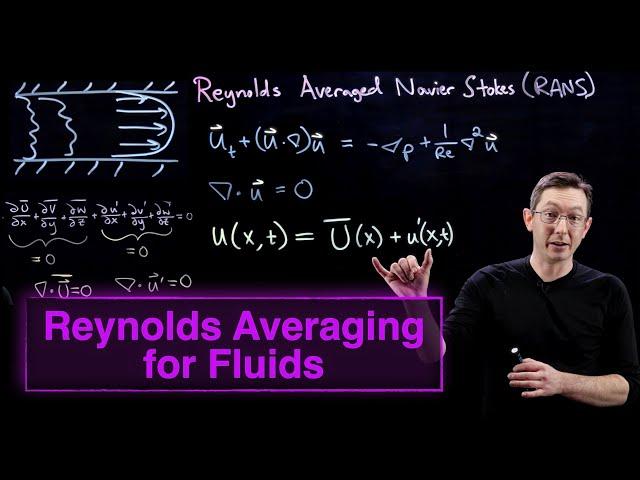
Turbulence: Reynolds Averaged Navier-Stokes (Part 1, Mass Continuity Equation)
Комментарии:

It's was amazing thank you!
Ответить
I am astounded by how fluently you are able to write backwards. Incredible lecture!
Ответить
Thanks for the video
Ответить
I work in applied ML research but come from a fluid dynamics background. You have just reminded me how fun this is and I am going to brush up on my vector calculus. Thank you.
Ответить
Steve, can you do a video on moving boundary heat transfer problems?
Ответить
Cant wait for more! Best content on YT
Ответить
Wow 😁😁😁
Ответить
I think it's important to let the general audience know that the derivation begins with the non-dimensionalized form of the incompressible Navier-Stokes and continuity equations. Non-dimensionalization of the continuity equation is less of a concern since it retains its original form but the N-S equation may initially confuse those less familiar with the non-dimensionalized form. Thank you for a great series of videos.
Ответить
Awaiting for a second part. Great video.
Ответить
wow impressive the ability to write backwards
Ответить
I'm an aerospace engineering student mostly focused on control engineering and I have to say - although I don't pursue any fluid dynamics anymore - you are the best professor I have seen so far. Your style of teaching is absoluty extraordinary. It's good friday, exams are over and here I am watching your videos out of pure curiosity. Your control videos helped me a lot in my studies but this turbulence series isn't even relevant to my studies but it is sooo interesting. Thank you so much for that!!!
Ответить
Dr. Steve I really love your videos keep explaining this awesome topics <3
Ответить
When you speak of time averages of derivatives, do you meant time averages of spatial derivatives?
Ответить
When introducing the time averaged by the integration at the beginning, shouldn't it be normalized by T? i.e., 1/T*(the integral)? Otherwise as T goes to infinity, the integral goes to infinity as well.
Ответить
I love this series! great video
Ответить
"IT'S GONNA BE A MESS! ... but kind of fun :)"
Ответить
Hi Steve, your videos about fluid and turbulence in general are so interesting and easy to understand. I have been studying for my turbulence course and your contents help me clarify these concepts a lot. Please keep making more of these awesome videos. Cheers!
Ответить
Really cool. Thanks for the recap at the end. That was very useful. I'm just trying to get the "big ideas" out of this series, so I appreciate that. Fascinating stuff, no doubt and I'm excited for the next installment.
Well, you gave "zed" and honest go. ;-) I'm sure the international crowd appreciates it.

Hello Prof. Burton, could you please mention what sort of accessories one needs to record such excellent lectures..what are you using?
Ответить
Steve, I just need to say thank you very much. I just started my thesis on the turbulent boundary layer flow in the Hypersonic regime using a RANS simulation and your videos on Turbulence are really helpful and interesting. I am following these as basically a lecture on RANS as i dont remember anything from when i actually studied them. Thanks a lot
Ответить
I've just finished my Master's and this is so much better than any class I had during graduation some 10 years ago. I wish this was available earlier! This serves not only as a refresher, but your ability to summarize a complex topic in a concise video is remarkable, makes it easier to organize the thought process and keep in mind the important ideas while deriving the equations. Thank you!
Ответить
Excellent content please keep up the amazing work!
Ответить
WHAT have I just seen? is incredible, going right now to the next episode
Ответить
Mod-06 Lec-35 Derivation of the Reynolds -averaged Navier -Stokes equations
Ответить
You are the best! Thanks!
Ответить
Hi Steve, thanks for all of your CFD videos and how in depth you make them .
Ответить
this video should be watched by entire mechanical engineering student who excited in fluid dynamics field. Thank you, SIr!
Ответить
this really helps me a lot sir, thank you so much!!
Ответить
When saying function of x and t , does this mean that flow is only x dependent concerning space ? Because there is a gradient in y direction in the flow profile as you draw it.
Ответить
I really like it, Thanks a bunch sir
Ответить
Not really related to your topic, but as i watched your video, I became mesmerized that for you to write on glass and for me to see it, the letters should be a mirror image. So i started thinking that you are amazing to be able to write in a mirror image. That seems improbable so came up with the thought that the camera is looking at a mirror of you writing on glass.
Am i right?

Steve I follow all of your lectures. Being a mechanical engineer I really got amazed by watching your turbulence lectures. I personally worked with CFD using scientific python and visualization and computation using python and published a couple of research articles. I'm very eager to work under your guidance in the field of CFD and Fluid dynamics using Machine learning specifically simulation and modelling turbulence fluid flow field and explore the mysterious world of turbulence. How should I reach you for further communication?
Ответить
your voice make me relaxed
Ответить
Just finished a MSME and one of the last things I started studying was turbulent flows. Now I am gearing up to write a proposal for a scholarship and will be applying to come study this with you hopefully Fall 2023 as a PhD student! I will have my ducks in a row - I promise!
Ответить
When you calculate U bar, the contribution of u'(x,t) is included, right ? Then you add u'(x,t) again. Are you double calculationg u'(x,t)? As I see it, U bar should be the time-invariant term, but the integration is along time domain....So I am confused. Could you please explain it?
Ответить
One of the best explanation I've ever heard! Thank you for this short and nonetheless informative lecture, Prof. Brunton!
Ответить
Was sat here thinking how impressive it is he can write backwards, until I realised he probably just flipped the video, I'd like to be wrong though!
Ответить
Okay good
Ответить
You teach so good that even a 15 year old like me can even understand
Ответить
where is the rho?
Ответить
May be I am making a mistake but I could not figure out how average of sums is equal to sum of the averages. Instead average of sum is average of the sum of the averages. Let’s say both, u and v, have an average between 0 and 1. The sum can be higher than 1. Whereas if I sum up u and v and then calculate average, it will be below 1. So, bar(u+v) = bar(bar(u) + bar(v))
Ответить
Great video! It also would be very interesting to learn about ensemble averaging and URANS models for unsteady flows
Ответить
Hello Prof. Steve, can you please clarify my doubt about differentiability of fluctuating velocity term in Reynold's decomposition. It is randomly varying component in space and time ( that's why we are talking about its mean and variance) then how can we define its spatial and temporal derivatives in traditional calculus way?
Ответить
Great Thanks!
Ответить
The Navier-Stokes equations can be calculated using the following formula: e^π+ie^πi +je^πj+ke^πk+le^πl=MC ^2
e^πi-1=0
e^πi =cos(π/2)+isin(π/2)
tan(π/2) ≡(±)∞
1 ≡π
ζ(1/2±i) ≡tan(π/2)
(±)0 ≡(±)∞
The tan function is the Lorentz transformation.
jkl=0, i ≡j ≡k ≡l
Quaternion
Octonion
The three tangent points of the three sides of the triangle circumscribing the unit circle correspond to the x-axis, y-axis, and z-axis.
The unit circle is drawn from the e^π of the hypersphere on a two-dimensional plane, and the circumscribing triangle is drawn.
When three points on the circumference of a unit circle are transformed by a rotation, the solution is found in terms of infinitesimal angular momenta Δx, Δy, and Δz. The x-axis, y-axis, and z-axis are invariant to the rotation transformation.

Probably the only dude I’ve come across that actually knows what’s going on 😂
Ответить
Steve, I love your turbulence videos. Just want to point out that I think you missed a "1/T" multiplying the integral when you calculate the mean velocity.
Ответить



















